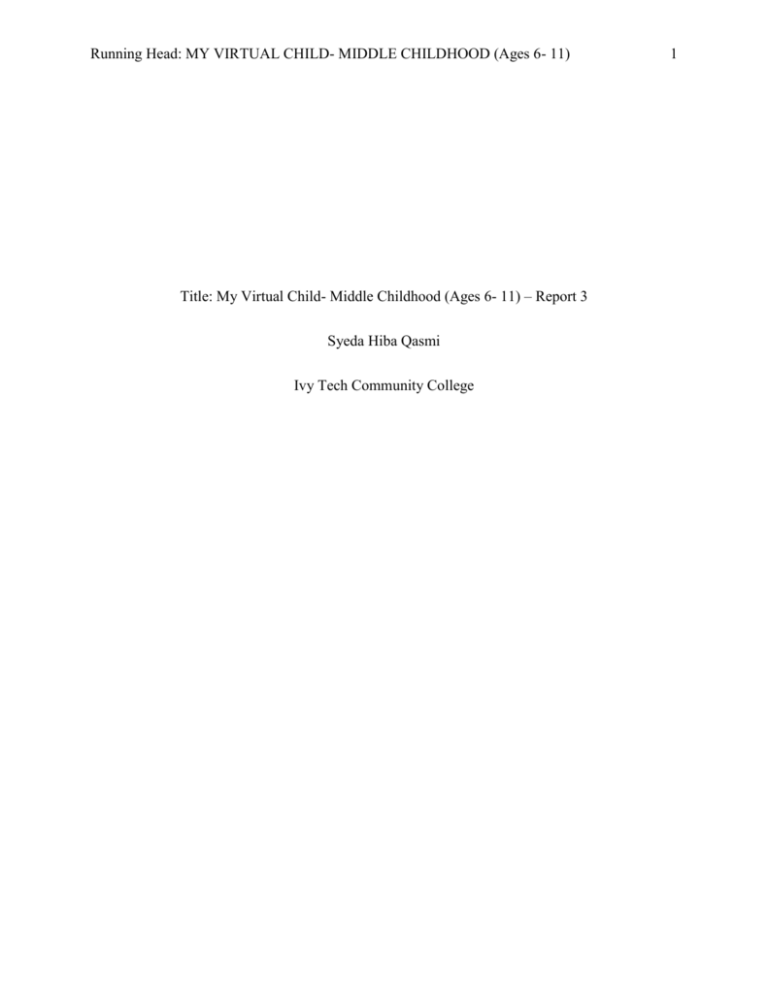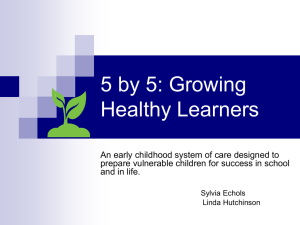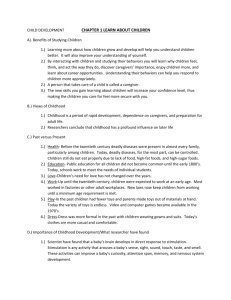My Virtual Child Report 3
advertisement

Running Head: MY VIRTUAL CHILD- MIDDLE CHILDHOOD (Ages 6- 11) Title: My Virtual Child- Middle Childhood (Ages 6- 11) – Report 3 Syeda Hiba Qasmi Ivy Tech Community College 1 MY VIRTUAL CHILD- MIDDLE CHILDHOOD (Ages 6- 11) 2 InTASC Standard, Description, Rationale Standard # 4 Content Knowledge The teacher understands the central concepts, tools of inquiry, and structures of the discipline(s) he or she teaches and creates learning experiences that make the discipline accessible and meaningful for learners to assure mastery of the content Name of Artifact: My Virtual Child- Middle Childhood (Ages 6- 11) Date: April 20, 2014 Course: EDUC 121 Brief Description: For this assignment I am reporting the growth process of my virtual child Hajarh. Her report includes her middle childhood years which include her age from 6 years of age up to 11 years of age. This report will include Hajarh’s specialist reports related to her growth pattern, which includes her typical and atypical growth factors. This report will assist me in raising Hajar in a better growth development procedure, which will lead Hajar become healthier child. Rationale: To document my understanding of Standard# 4 Content Knowledge, in this assignment I have included my Virtual Child, Hajar. I have included the various developmental patterns whether they are typical for her age group, which is 6- 11 years of age. This report helps in working on the areas of the child that require extra support in developing a child on the typical growth pattern of their age group which are healthy and beneficial for the child. MY VIRTUAL CHILD- MIDDLE CHILDHOOD (Ages 6- 11) Introduction: This report includes Hajar’s developmental process from her middle age years which include ages 6- 11 years of age. This assignment will help in understanding the areas that Hajar needs assistance in developing in a healthy and typical growth pattern which is essential for her age. Adaptation to the Social Environment: According to The Future of Children, by Princeton Boookings; Erik Erikson, who proposed the "eight stages of man" depicted in Table 1, stressed the importance of middle childhood as a time when children move from home into wider social contexts that strongly influence their development.2 Erikson viewed the years between 7 and 11 as the time when children should develop what he called "sense of industry" and learn to cooperate with their peers and adults. The involvement in formal schooling and organized activities that begins during these years, introduces children to new social roles in which they earn social status by their competence and performance.3 Children who do not master the skills required in these new settings are likely to develop what Erikson called a "sense of inferiority," which can lead, in turn, to long-lasting intellectual, emotional, and interpersonal consequences. According to Hajarh’s Psychologist’s report in adaptation to the school and social environment, “Works cooperatively in groups, usually respects rights and property of others, and usually demonstrates appropriate peer social interaction, She was friendly to the examiner and remained calm and cheerful during the IQ and achievement tests even when some of the questions became difficult and frustrating”. 3 MY VIRTUAL CHILD- MIDDLE CHILDHOOD (Ages 6- 11) 4 Hajarh is pretty good in school and social environment, rally enjoys her time, with her class fellows and friends. Multiple Intelligences: There are a variety of approaches to the study of individual differences in cognitive ability. Three areas that are commonly assessed by current cognitive abilities tests are verbal ability, spatial ability, and logical-mathematical ability. Howard Gardner's multiple intelligences approach added additional domains of intelligence based on developmental and neuropsychological evidence: musical ability, physical/athletic ability, intrapersonal skill (understanding of the self or emotional intelligence), interpersonal skill (social competence), and more recently, naturalistic intelligence (understanding of the natural world). In the program, levels of verbal, spatial, logico-mathematical, musical and bodily-kinesthetic ability are preset to random values at birth. These abilities can be changed slowly by a large number of environmental factors. The behavior of the child at any given point is consistent with the child's developmental level. For example, a child with high musical ability in middle childhood will be enthusiastic and talented in the school instrumental program, a child with average musical ability will take up an instrument, learn something about music, but not become accomplished at it, and a child with low musical ability will be uninterested in playing an instrument and unable to carry a tune. The student parent has choices whether to push the child in each ability domain, and in some cases this can result in steady progress. However, it is unlikely that a child at the bottom level of musical ability will attain the highest level by the end of the program. To cite another example, children who are low in verbal ability go through the language milestones (such as speaking in grammatical sentences) at a slower rate, and have lower interest in reading and lower MY VIRTUAL CHILD- MIDDLE CHILDHOOD (Ages 6- 11) 5 reading comprehension later in childhood, than children of average or above average ability. Intrapersonal and interpersonal intelligence are captured by underlying variables in the program such as attachment security, emotionality, peer competence, self-control, and the three personality types. These aspects of the child can change somewhat more than the cognitive abilities in response to cumulative effects of social experiences and parenting choices. Typical American Gender Role in Hajarh: Children's gender identity (e.g., their ideas about what it means to be a boy or girl, and how notions of gender apply to them) develops in complexity during the middle childhood years. At this developmental moment, children have become aware of gender stereotypes having to do with how boys and girls are "supposed" to think and act. Correspondingly, children start to identify certain activities and abilities as being characteristically "masculine" or "feminine". This new awareness may affect their willingness to engage in behaviors not characteristic of their own gender, even if they previously used to enjoy those behaviors. (Oswalt, A.). As Hajarh is growing, she is becoming more social. She is adapting and becoming more responsible therefore, I started to assign her various house hold chores, which she tries to complete according to her skills. I think that American children become much more independent and responsible as compared to other cultures in the world, and Hajarh is very much influenced by it. She has become extremely social with her friends in class and her neighborhood. Which I think will happen because culture and environment has a huge influence on individual, especially the children who are in their developing phase. MY VIRTUAL CHILD- MIDDLE CHILDHOOD (Ages 6- 11) 6 Academic Progress: Some highlights of the 5th grade report card were as follows: Usually works cooperatively in groups, usually respects rights and property of others, and usually demonstrates appropriate peer social interaction. "Demonstrates strength" in all areas of reading, and in spelling and "appropriate for grade level" in writing. In the comments section the teacher wrote: Occasionally Hajar gets upset during stressful situations inside or outside the classroom, but usually is able to bounce back quickly. "Appropriate for grade level" in the areas of speaking and listening and in content knowledge of social studies and science. "Requires more support" in the areas of mathematical problem solving, understanding of data, number concepts, graphical applications, and arithmetic computation. "Demonstrates strength" in the area of art. "Appropriate for grade level" in the area of music. Consistently works independently, listens attentively, and follows directions and classroom rules. According to my observation, I see Hajar still struggling in some academic areas, especially reading, and verbal communication skills. Since I am working, and her teachers are very cooperative, I believe that she is going to get better at it. MY VIRTUAL CHILD- MIDDLE CHILDHOOD (Ages 6- 11) 7 Behavior and Emotional Problems: To age seven and you'll see that the child has become quite adept at doing things independently and is probably quite proud of such accomplishments. During middle childhood, kids become more competent and confident. Parents begin to place trust in the child, allowing him to take on daily tasks such as selecting his own clothes and making his own breakfast. Family friendships are still vital, but children are far less clingy at this age. (Kendra, C.). Hajar is very cooperative as compared to her early childhood years. She pretty much tries to be independent, and since I have seen her independency development I have given her some house duties, she has some responsibilities, and she tries her best to complete those chores. She is very social with her friends and neighbors, and really enjoys her time with them. She also discusses her issues at home with me as well, she also plays with her young sister Sarah. She is pretty healthy and has a very good behavior for her age group. Parenting Style: There are various parenting styles, but as my previous reports as well I do not particularly follow one specific theorist, or practice one developmental pattern or technique. I follow any strategy that suites according to the situation. I follow different techniques that my friends suggest, and of course if they are appropriate for the situation, and also some of my parents strategies that my parents applied on me in my developmental period. The point is that I do not follow one specific developmental chart or technique. MY VIRTUAL CHILD- MIDDLE CHILDHOOD (Ages 6- 11) 8 Personality Type: Hajar has changes a lot since age 4. At age 4 she was pretty scared with strangers, and kind of very cranky as well. As she has reached her mid childhood age group, she has a drastic change, she has become very friendly with strangers, and very social girl. She has started helping me a lot at home and also plays with her young sister, Sarah. As I see her, I see a lot of similarities of her behavior that resembles my behavior when I was young. As my mother used to tell me that I was pretty cranky in my early childhood ages, but until I reached the age of 6 or 7, I became really social that sometimes my mother used to yell at me to actually, “Shut up!” I was very friendly with strangers, and my friends, I loved helping any elder in the house, whether they were cleaning or cooking. Hajar resembles me in talking habit and helping at home. Bronfenbrenner Model: Urie Bronfenbrenner (1917-2005) developed the ecological systems theory to explain how everything in a child and the child's environment affects how a child grows and develops. He labeled different aspects or levels of the environment that influence children's development, including the microsystem, the mesosystem, the exosystem, and the macrosystem. The microsystem is the small, immediate environment the child lives in. Children's microsystems will include any immediate relationships or organizations they interacts with, such as their immediate family or caregivers and their school or daycare. How these groups or organizations interact with the child will have an effect on how the child grows; the more encouraging and nurturing these relationships and places are, the better the child will be able to grow. Furthermore, how a child acts or reacts to these people in the microsystem will affect how they treat her in return. Each MY VIRTUAL CHILD- MIDDLE CHILDHOOD (Ages 6- 11) 9 child's special genetic and biologically influenced personality traits, what is known as temperament, end up affecting how others treat them. Microsystem: Involves her house and her school and restaurants where she dines in, she know how to behave according to her situation. Mesosystem: When Hajar goes to her school she has different rules and regulations set at school which she follows, whereas at home she has different set of rules set by her parents. She makes connections between both, it is good for her development because it makes her personality flexible. Exosystem: One example for this would be that whenever I and my partner have issues and we show our temper with each other, it does influence Hajar, and sometimes I see her being aggressive in certain situations. Secondly, when I discuss some matters with my mother on phone, and also tell her all the time that mothers need to know everything we are doing, and in any hard time we need to tell our mothers, and also I have fed in her brain that mothers are the only best friend, so she shares different matters with me all the time. Conclusion: This assignment helped me in recognizing the typical and atypical developmental patterns for Hajar, and whether they are healthy for her physical and emotional growth. It also helps me seeing a clear picture of how she has changed since her earlier years, which really makes me happy that she is becoming a big girl, and is becoming independent. MY VIRTUAL CHILD- MIDDLE CHILDHOOD (Ages 6- 11) 10 References Cherry, K. "Social and Emotional Development in Middle Childhood." About.com Psychology. N.p., n.d. Web. 20 Apr. 2014. http://psychology.about.com/od/early-childdevelopment/a/social-emotional-development-in-middle-childhood.htm Oswalt, A. "Gulf Bend MHMR Center." Gulf Bend MHMR Center. N.p., n.d. Web. 20 Apr. 2014. <http://www.gulfbend.org/poc/view_doc.php?type=doc&id=7930&cn=28>. Oswalt, A. "Seven Counties Services Inc." Seven Counties Services Inc. N.p., n.d. Web. 19 Apr. 2014. <http://sevencounties.org/poc/view_doc.php?type=doc&id=37696&cn=1272>. University, Princeton. “- The Future of Children -." Princeton University. Trustees of Princeton University © 2014, 11 Feb. 2013. Web. 20 Apr. 2014. <https://www.princeton.edu/futureofchildren/publications/journals/article/index.xml?jour nalid=48&articleid=232§ionid=1518>. MY VIRTUAL CHILD- MIDDLE CHILDHOOD (Ages 6- 11) 11







